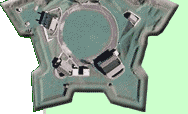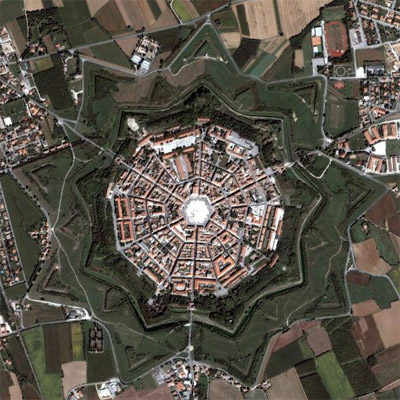
 |
 |
Palmanova Palmanova, Italy |
 |
 |
 |
 |
 |
||
 |
On October 7 1571 The naval forces of the Holy League (a coalition of Spain, the Republic of Venice, the Fightin' Papacy, the Knights Hospitaller and others) defeated the Ottoman Empire's main fleet in the Battle of Lepanto. This last battle fought between oar-powered galleys gave the Holy League temporary control of the Mediterranean Sea and stopped further Turkish advance into Europe. Chuffed over its participation in this historic event and in the interest of preventing future Ottoman tentacles from slithering their way into the Italian peninsula, in 1593 the Republic of Venice founded a new kind of settlement on the Battle of Lepanto's 22nd anniversary: Palmanova. Situated precariously close to the border with modern-day Slovenia, Palmanova was to be a fortified city that utilized the most modern notions of military fortification...and its founding date left no doubt as to its intended purpose of nipping the Ottomans in their bud at the Venetian border. Upon completion of this shiny new city, which was designed to be inhabited by a self-sustaining population, a problem emerged: Nobody wanted to live there! In desperation, the Venetian government pardoned a number of prisoners in 1622 and gave them property in Palmanova...finally, a brave, self-sacrificing group of settlers, dedicated to standing up to the Turks! Perhaps Palmanova's powerful pointyness dissuaded the Ottomans from further advance, but Napoleon (1769-1821) wasn't the least bit put off. The Treaty of Campo Formio (1797) effectively ended the First Coalition, or the alliance of states that first attempted to stop Napoleon from his Napoleony doings, by somewhat allying Austria, which had previously been against Napoleon, with France. The treaty divided Venice and its territories betwixt France and Austria, and giving the Austrians a foothold in Italy pretty much guaranteed further conflict in the region. Palmanova's ring of outer fortifications was completed during this Napoleonic era. In 1806 the Kingdom of Italy captured Palmanova, but after Napoleon's defeat in 1814-1815 the city came back under Austria's control: It would remain part of the Hapsburg Empire until 1866, with a brief foray into anarchic non-Austrianness in 1848. Guiseppe Garabaldi (1807-1882), who eventually would help to bring about Italian independence from Austria and unification with itself, arrived in Italy amidst the general mess of revolutions in 1848. Garibaldi had been participating in various South American conflicts for several years, and was happy to leap into the fray in his home country. Palmanova was one of several cities that were seized from the Hapsburgs during this year of conflict, but the Austrians were able to reassert their control: Garibaldi was exiled to the United States, but returned in the 1850's to do that Italian independence thing. Austria-Hungary was all too pleased to participate in Italian bashings-upon during the First World War (1914-1918). Palmanova's strategic location made it a logical base for the Italian military, which set up hospitals, storage facilities and drilling grounds in the area. Palmanova was severely damaged during the Battle of Caporetto in October 1917, in which Austrian and German troops, made available by Russia's heroic withdrawal from the war, poured into northeast Italy. The Italians were eventually able to contain the threat, but at the cost of 700,000 casualties. During the Second World War (1939-1945) Palmanova was used as a base for Italy's efforts against anti-fascist partisans who were operating in the region. Palmanova was declared a National Monument in 1960. Today, it exists as an awfully attractive city from the air, in which people dress up in 17th century clothing on the second Sunday of every July, to commemorate the first time the Republic of Venice's flag was hoisted in 1602. |
 |
 |
||
|
|
|||||||
Info Source 1 Info Source 2 Info Source 3 Info Source 4 Info Source 5 Info Source 6 Info Source 7 Info Source 8 Info Source 9 Thanks to Google Maps for the image! ©2010 starforts.com |
 |